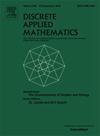Discrete isoperimetric method for bandwidth, pathwidth and treewidth of hypercubes
IF 1
3区 数学
Q3 MATHEMATICS, APPLIED
引用次数: 0
Abstract
Let denote the clique number of graph . The treewidth of is the minimum of taken over all chordal supergraph of . The pathwidth and the bandwidth can be defined in a similar way when the chordal graph is replaced by an interval graph or a proper interval graph respectively. It follows that . A -dimensional hypercube is the graph with vertex set of all -tuples with where two vertices are adjacent if they differ in exactly one coordinate. In order to determine the bandwidth of hypercubes, Harper (1966) proposed a powerful discrete isoperimetric method. Later, it was shown that , but is unknown so far. In this paper, we review the discrete isoperimetric method for , , and . In particular, we show that for (it is trivial that for ).
求助全文
约1分钟内获得全文
求助全文
来源期刊

Discrete Applied Mathematics
数学-应用数学
CiteScore
2.30
自引率
9.10%
发文量
422
审稿时长
4.5 months
期刊介绍:
The aim of Discrete Applied Mathematics is to bring together research papers in different areas of algorithmic and applicable discrete mathematics as well as applications of combinatorial mathematics to informatics and various areas of science and technology. Contributions presented to the journal can be research papers, short notes, surveys, and possibly research problems. The "Communications" section will be devoted to the fastest possible publication of recent research results that are checked and recommended for publication by a member of the Editorial Board. The journal will also publish a limited number of book announcements as well as proceedings of conferences. These proceedings will be fully refereed and adhere to the normal standards of the journal.
Potential authors are advised to view the journal and the open calls-for-papers of special issues before submitting their manuscripts. Only high-quality, original work that is within the scope of the journal or the targeted special issue will be considered.
 求助内容:
求助内容: 应助结果提醒方式:
应助结果提醒方式:


